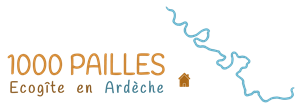
An ecological project
Work on the gîte began in 2014 and lasted three years (in parallel we had started the construction of the main building).
We were staying in the gite from 2016 until it opened in July 2018.

Why did we choose the name 1000 Pailles?

Straw is the main insulation of our buildings. The project involves approximately 1000 straw bales. They are divided into 300 for the construction of the gite and the rest for the main house.
We wanted to make a healthy accommodation in harmony with its environment by using materials of natural origin with low ecological impact.
Having never built a house before, to learn about and train in construction, we did internships and a few participatory sites before embarking on the project. 
The straw bales are placed in a corridor formed by a double wooden frame. It remains today only visible through the "window of truth" located in the living room.A lightweight mortar, which can also be seen through the "window", composed of sawdust, lime, sand and a small proportion of cement covers the straw on the outside and inside to form a solid and coherent wall .
This process corresponds to the GREB technique (Groupe de Recherches Écologiques de la Baie) developed in Quebec. To this day, there are many houses in France built using this method. 
The materials inside are also of natural origin, such as the earth armatures applied to the walls. We ""tested"" different mixtures, including the red earth plasters from our own land on the walls of the north bedroom.
For the floor of the living room/kitchen and the hallway we used terracotta floor tiles (pare-feuilles) from an old house in the Drôme.
In addition to the straw which provides very good thermal insulation in the walls, the house is also insulated with blown-in cellulose wadding in the attic, as well as with cork placed under the screed. We opted for Douglas wood cladding on the outside. All the boards were painted using an ecological "homemade" paint based on flour, according to an old recipe of Scandinavian origin.
We have installed solar panels to heat the sanitary water. The toilets are water-saving (the hand shower is only used for cleaning the carpet), the materials are treated by composting while the urine is sent to phytopurification (treatment of gray water by plants). We source our electricity from Enercoop which is an original electricity supplier 100% renewable.
On the roof of the main house we have installed 9 kwc of photovoltaic panels. This installation of electricity production as well as the low level of consumption of the buildings makes it possible to obtain a positive energy balance of the site (more energy is produced here than it is consumed).
Our project continues with the development work of the main house.





